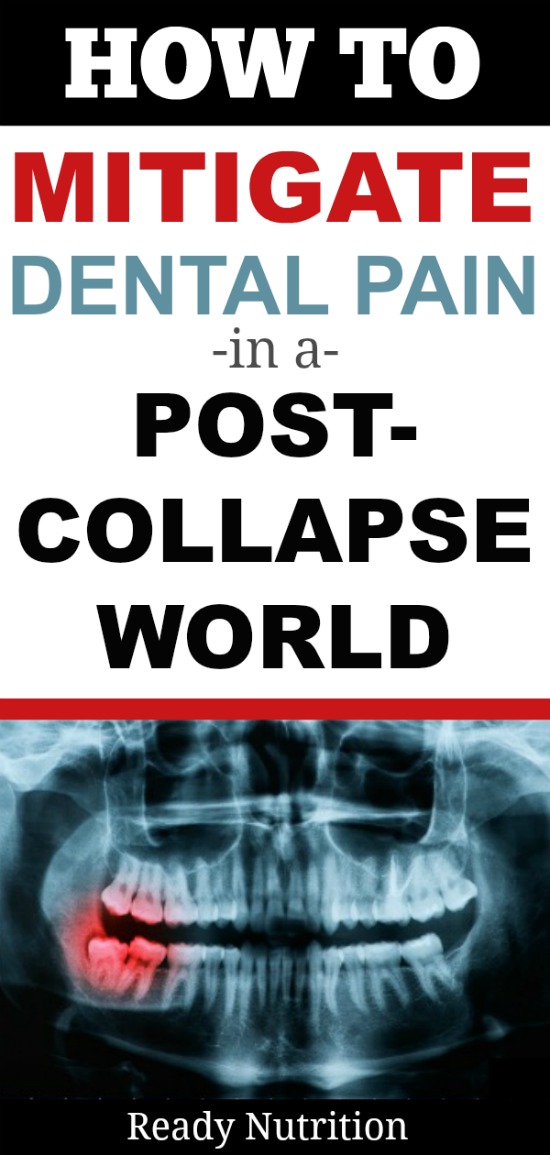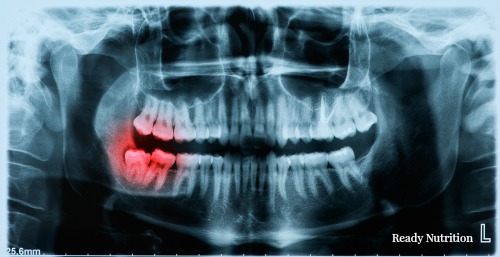[Editor’s Note: We have a tendency to forget how an innocent tooth issue can quickly exacerbate into a life-threatening emergency. Without warning, pain, soreness and infection can occur in the gums or teeth causing extreme discomfort. Although certain foods can have a cleaning effect on your teeth, there are other natural alternatives that you can turn to keep your teeth and gums clean. Knowing these alternatives, as well as the vitamins needed to maintain teeth and gum health will help you maintain continued health in a disaster.]
Hello there, Ready Nutrition Readers and colleagues in the battle to plan and prepare for the worst! Today’s topic of discussion will focus on tooth care and tie it into additional problems societal collapse/disaster survivors will face.
Dental caries (also commonly known as cavities) is tooth decay and leads to progressive decalcification of the enamel and dentin of a tooth. Decalcification is a term to describe the loss of or erosion of minerals (such as calcium) that make up teeth and bones. There are many types of cavities, and those most commonly seen are as follows:
- Necrotic caries: cavities caused by dysfunction (usually hyper) of a person’s salivary glands (they contain powerful enzymes that serve digestive functions).
- Rampant caries: sudden, acute caries running to the depth of the tooth-pulp; almost all of the teeth (with this type) are affected.
- Recurrent caries: these occur in cases where dental work/restoration has been done, and tooth surface flaws cause gaps to form where plaque enters and enlarges the cavity.
- Root caries: entails a cavity on the root of the tooth, an area that is more susceptible to cavities due to lack of protective enamel.
With the onset or maturation of any of these types of caries, a person may experience pain (sharp and sudden when chewing, or dull and aching during the course of the day) and sensitivity to temperature. The latter is especially true when drinking cold beverages or hot ones, such as coffee or tea. Swelling of the gum area around the tooth or in its immediate vicinity is also a symptom.
Teeth will suffer some problems in a post-collapse situation for several reasons:
- Availability of clean water and food will be more limited
- Availability of medical and dental supplies will be even more limited
- Dentists will be unavailable; you’ll be your own “dentist” for the duration of the emergency (and possibly then some!)
- The body will be debilitated from the various collapse conditions pervasive no matter what area one resides in
Prepare for dental emergencies with these two supply lists: Short term dental emergencies and long term emergencies
I highly recommend reading several articles previously submitted on Ready Nutrition:
- Post-Collapse Food Will Probably Make You Sick. Here’s What You Need To Know
- Toxic Food: 1 in 6 Americans Come Down with This Potential Life-Threatening Illness
- Survival Water Fundamentals: 9 Common Waterborne Diseases and How to Treat Them Naturally
All of these articles are important, as they present many of the diseases that will run rampant during and after a societal collapse. When the teeth are weak or debilitated, it is a well-known fact that the mouth can then become a more effective portal for the introduction of many diseases and pathogens. Such is the reason that our main focus in this piece is the control and explanation of the cavities, as they are the gateway to the beginning of other oral problems that are more serious by nature.
Caries is also caused by excessive or high amounts of sugars or carbohydrates, by unplanned meal menus, overeating, or eating in-between meals. Good oral hygiene as recommended by your dentist is the key to prevention and control. Brush and floss regularly after each meal and ensure regular checkups by your dentist. In a post-collapse situation, do not rule out finding a dentist and bartering some commodity or supply you either have or produce (or both) in return for dental services! Be advised, however, that there are some natural foods that may alleviate your discomfort.
Cloves (Syzygium aromaticum) have been used successfully for almost all forms of tooth pain throughout the ages. Clove oil, in particular, is an extract available commercially. The oil contains Eugenol, a volatile oil with both analgesic and anti-inflammatory effects. Clove oil has demonstrated anti-microbial effects as well against Staphylococcus aureus, and Escherichia coli. The former is endemic to our nasal passages, and as the mouth and nasal passages find common ground, one can see a propensity toward infection. E. coli can be found just about anywhere you place your hands during the course of the day. Clove oil can help with pain and fight infection.
Green Tea (Camellia sinensis) has anti-inflammatory effects and also anti-microbial (the latter specifically toward caries). A moistened tea bag can be placed between the gum and cheek near the afflicted tooth to take down the swelling. A double-blind study on 26 adult males resulted in a plaque inhibition of 30-43% when Green Tea was employed as a mouthwash, as well as decreasing caries-causing bacteria.[1]
Green Tea directly inhibits caries-flourishing bacteria, such as E. coli, S. salivarius, and S. mutans.[2] The tea is (demonstrably) a weak inhibitor of the enzyme salivary amylase, (as glanced upon earlier) a powerful enzyme that is the primary culprit (via hyper-secretion) with Necrotic caries. Such is why the dentist is so vital to diagnose underlying reasons for the caries. Green Tea intake can be 2-3 cups per day; swish and gargle with it before swallowing the tea.
More on toothpaste: personally I have found Colgate Total to be an excellent choice to help keep the teeth and gums clean. Such is due to the presence of Triclosan, in 0.30% concentration, listed for the indication of an antigingivitis component. In the absence of toothpaste, baking soda can be substituted. A salt-water rinse for brushing of the teeth and gums can also be prepared using a ratio of ½ tsp salt to 8 ounces of water.
Now to briefly address complications beyond simple cavities and inflammations, there is an important resource you may wish to have in your survival library. Entitled, “Where There Is No Dentist,” by Murray Dickson, with 228 pages packed with photographs and illustrations. The work details maintenance of teeth, the diseases that are predominant with the teeth, and dental procedures (such as scaling, tooth removal, etc.), as well as tools and equipment. I consider it an invaluable tool for the grid-down collapse library.
As can be deduced from the information presented earlier, the Green Tea may be used as a preventative measure; however, its effects on bacteria will serve you well should you have tooth pain or pain in the gums by keeping the bacteria “at bay” regarding further infection. The key to all of these measures in a grid down situation is to discipline yourself regarding adherence to oral hygiene. I urge everyone to stock up on toothbrushes, toothpaste, floss, and all of the necessities for proper tooth care. Such measures can only pay off in the long run, and any surplus can be used for barter if necessary.
Taking things a step further: find out where the dentists in your neighborhood live and see if you can build a rapport with them. Sure, it seems strange now; however, take it as an opportunity. Without going into lucid detail, there is a dentist within ½ mile from where I live and I have already made arrangements with him to trade certain services of mine for his should the need arise. Remember the old saying: An ounce of prevention is worth a pound of cure. The adage holds true. Prepare and you’ll be prepared. Hope this article is something you can “sink your teeth into,” and you guys and gals have a great day!
JJ
[1] Dr. Janicke, Christof. “PDR for Herbal Medicines, 3rd Ed.” Thomson PDR, Montvale, NJ 2004. ISBN:
1-56363-512-7, p 411.
[2] Ibid., p 409.

This article was originally published at Ready Nutrition™ on May 11th, 2015








Excellent piece JJ, thank you.
Theres about as much or more of a chance of dying from poor nutrition and complications after SHTF.
Great article.
For severe mouth trauma (smashed teeth, etc) , with no Dentist and only non prescription drugs available, this works and should be kept in your bug out bag.
Gargle (do not swallow )mixture of 1/2 liquid Maalox and 1/2 liquid Benadryl (they still make it for kids).
Do not swallow, gargle only and spit it out. It will kill pain for hours.
I am not a Dentist, consult professional care if available.
I was out of town and had a tooth acting up. When I pressed at the base it started bleeding and tooth had a moderate throb. I bought some frankincense essential oil and saturated a small chunk of cotton ball and wedged it against the tooth during the first night. After that I just rubbed it on gums 2-3 times a day. Within a day or 2 it started settling down and no longer bothers me.